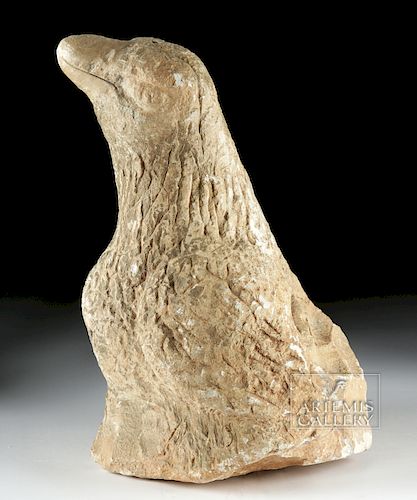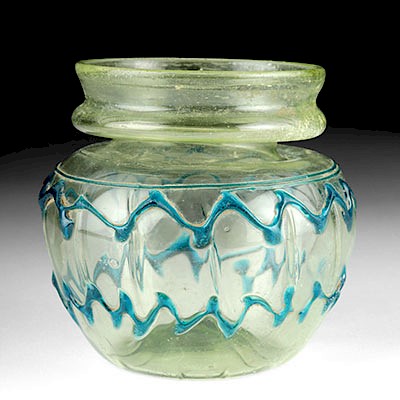Roman Imperial Limestone Statue of Eagle
Lot 34
About Seller
Artemis Fine Arts
686 S Taylor Ave, Ste 106
Louisville, CO 80027
United States
Selling antiquities, ancient and ethnographic art online since 1993, Artemis Gallery specializes in Classical Antiquities (Egyptian, Greek, Roman, Near Eastern), Asian, Pre-Columbian, African / Tribal / Oceanographic art. Our extensive inventory includes pottery, stone, metal, wood, glass and textil...Read more
Estimate:
$2,800 - $4,200
Absentee vs Live bid
Two ways to bid:
- Leave a max absentee bid and the platform will bid on your behalf up to your maximum bid during the live auction.
- Bid live during the auction and your bids will be submitted real-time to the auctioneer.
Bid Increments
| Price | Bid Increment |
|---|---|
| $0 | $25 |
| $300 | $50 |
| $1,000 | $100 |
| $2,000 | $250 |
| $5,000 | $500 |
| $10,000 | $1,000 |
| $20,000 | $2,500 |
| $50,000 | $5,000 |
| $100,000 | $10,000 |
| $200,000 | $20,000 |
About Auction
By Artemis Fine Arts
Aug 16, 2018
Set Reminder
2018-08-16 10:00:00
2018-08-16 10:00:00
America/New_York
Bidsquare
Bidsquare : Clearance Sale - Ancient / Ethnographic Art
https://www.bidsquare.com/auctions/artemis-gallery/clearance-sale---ancient-ethnographic-art-3368
These lots are going, going, gone... plus a nice selection of lots brand-new to auction! Artemis Fine Arts info@artemisfinearts.com
These lots are going, going, gone... plus a nice selection of lots brand-new to auction! Artemis Fine Arts info@artemisfinearts.com
- Lot Description
**Originally Listed At $1500**
Roman, late Imperial Period, ca. 3rd to 4th century CE. A substantial, hand-carved limestone eagle statue hewn from a larger stone. The avian figure displays its proud head in a majestic raised position, tilted just slightly in an inquisitive manner, its almond-shaped eyes and conical beak exuding a power evocative of the Roman legions which looked to it for inspiration. A pair of ovoid wings are tucked against the plump body with individually-formed feathers. The form of this statue, given its militaristic symbolism, was perhaps displayed outdoors in front of the palatial estate of a high-ranking military official or even near the gates of a military complex. Traces of original pigmentation remain, though the color has faded to a pale-tan hue. A beautiful and powerful example! Size: 10" W x 15.75" H (25.4 cm x 40 cm).
The eagle was a highly-symbolic animal among the Roman military and was a great symbol of pride and victory in the eyes of the legions. Known as "aquila" in Latin, the eagle was a representation of honor, victory, and cohesiveness within a legion. Stone effigies of the revered bird were typically displayed outside of prominent buildings likely used by members of the military elite or outside of palatial residences owned by the Roman aristocracy.
One member of each legion was referred to as an aquilifer, or "eagle-bearer," as it was his primary duty to carry and protect that legion's designated bronze eagle standard. If ever an aquila was lost or stolen, it was the primary obligation of the aquilifer to go to any lengths to recover the standard and see to its safe return. Losing an eagle standard was considered a grave omen for its respective legion and would typically lead to distrust and paranoia among the legionaries. To quote a piece of historical fiction set in Roman Britain entitled "The Eagle of the Ninth" (Rosemary Sutcliff, 1954), "Eagle lost, honor lost; honor lost, all lost."
Provenance: private New York, New York, USA collection
All items legal to buy/sell under U.S. Statute covering cultural patrimony Code 2600, CHAPTER 14, and are guaranteed to be as described or your money back.
A Certificate of Authenticity will accompany all winning bids.
We ship worldwide and handle all shipping in-house for your convenience.
#134558This is a fragment of a larger sculpture. Restoration to majority of beak. Surface wear and abrasions commensurate with age as expected, fading to finer carved details like feathers and facial features, roughness to most surfaces and base, and fading to pigmentation. Nice earthen deposits and traces of pigmentation throughout.Condition
- Shipping Info
-
All shipping is handled in-house for your convenience. Your invoice from Artemis Gallery will include shipping calculation instructions. If in doubt, please inquire BEFORE bidding for estimated shipping costs for individual items.
-
- Buyer's Premium



 EUR
EUR CAD
CAD AUD
AUD GBP
GBP MXN
MXN HKD
HKD CNY
CNY MYR
MYR SEK
SEK SGD
SGD CHF
CHF THB
THB
















